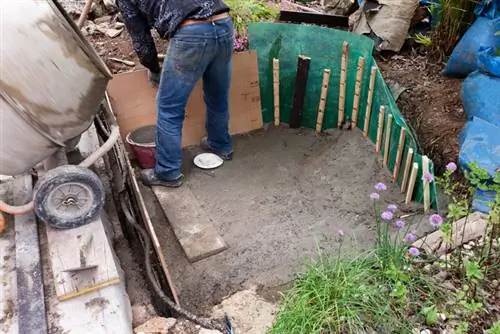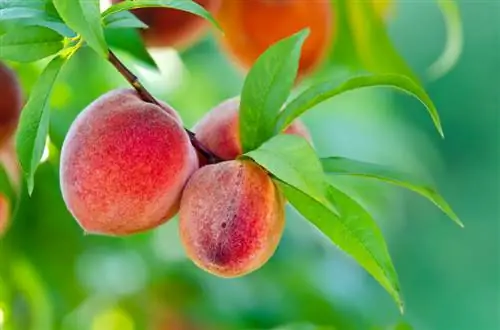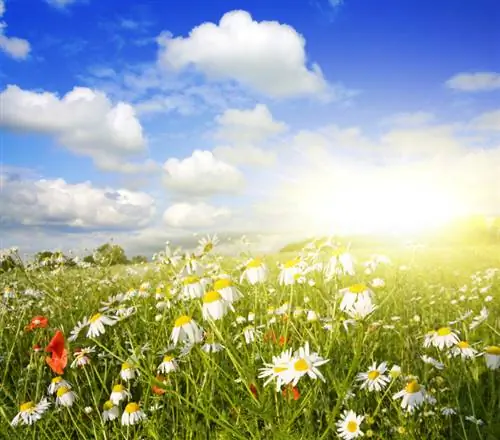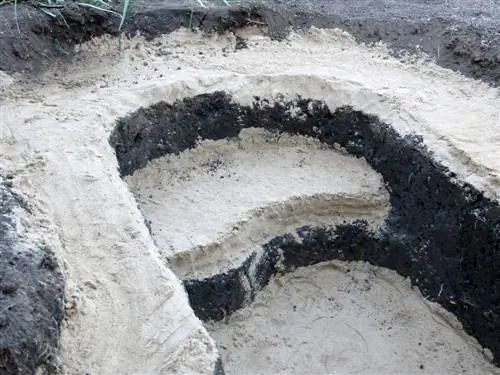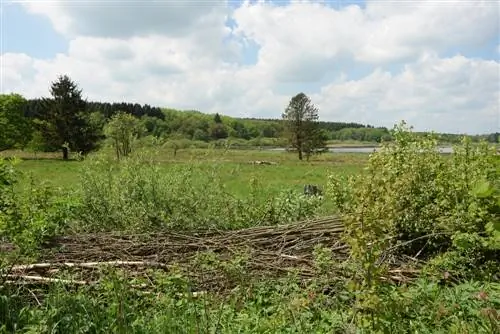- Author admin [email protected].
- Public 2023-12-16 16:46.
- Last modified 2025-01-23 11:21.
It is not easy to create a garden pond, especially on smaller properties. Sometimes the place is too sunny or too hilly, and the foliage of the trees also needs to be taken into account when building an ornamental pond. And: Safety plays a role before you decide on one of the five types of pond construction.
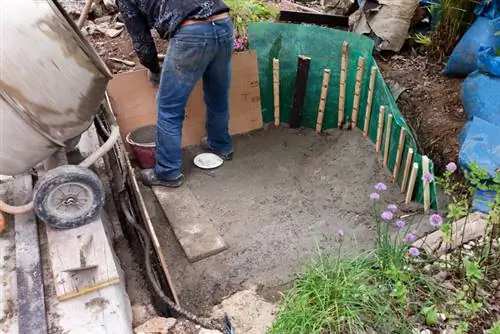
What should you consider when creating a garden pond?
When creating a garden pond, you should consider the location, shape, building materials and safety. Ideally, you should choose a location with a balanced light-shadow ratio, plan a natural shape and find out about suitable materials such as pond liner or prefabricated pools. Don't forget to take safety precautions for your pond system.
Inspiration often begins when you discover a pond while walking somewhere in nature that has been covered with wild water lilies over the course of many years, with summer flowers growing all around it and perhaps even a rustic one on the bank There is a wooden bench where you can take a breather. The idea of creating a similarly idyllic spot on your own property was born and took off. Even if this tranquil little pond in the great outdoors wasn't planned at all, but just came into being on its own, if you want to bring your dream pond into your own garden, you have to organize a lot in advance.
Where do I start when building a garden pond?
In addition to many detailed questions that arise about the construction technology and equipment of a garden pond, some basic considerations are first necessary, such as:
- Where is the best place to place my garden pond and how do I proceed structurally?
- Is it cheaper to buy a ready-made pool or should you use foil for your own decorative pond? Or are there perhaps other materials?
- How do I design the pond? Should bubbling spring stones ensure the flow of water or an underground pipe system that remains invisible?
- Which planting is optimal and what do I have to take into account when creating a garden pond?
Planning for building your own garden pond
So a whole range of factors have to come together, which, in addition to the optimal location of the new ornamental pond, also includes itssize and desired shape. After all, the new oasis should become a resting place in the garden and it is far from enough to simply shovel in any free space, because not every place is suitable for building your ornamental pond.
The right terrain for building a garden pond
Searching for a location is not particularly easy, especially on smaller properties. The unsuitable areas primarily include particularly pronounced slopes and garden areas with a high population of coniferous and deciduous trees. Experience has shown that the ideal location is within a lawn and is directly adjacent to trees and bushes, but not too close. Also important for later accessibility during upcoming maintenance measures would be a zone that is easily accessible from all sides for selecting the location of the ornamental pond to be created.
About light, shadow and the meaning of trees
Older and very large trees can make the necessary earthwork during excavation more difficult due to their overgrown root system. And if not now, perhaps in a few months or years when roots start to grow into the pond liner and this causes leaks. In addition, thefalling leaves in autumn can pollute the pond bottom, form foul gases in the water and have a negative impact on the nutrient content of the water. No less important are the lighting conditions, which must be carefully assessed during construction preparation, as they affect the growth of the pond plants. Avoid too much shade if possible, otherwise the water lilies will have a hard time blooming. The ideal pond location is exactly where:
- until 11 a.m. the sun can shine unhindered;
- there is partial shade between 11 a.m. and 3 p.m.;
A balanced ratio of light and shade directly benefits the water quality, because the more the pond warms up, the lower the oxygen concentration, which in turn promotes algae growth and enormously increases the risk of tipping.
Creating a garden pond: flat or with a slope?
From a purely visual point of view, a self-built ornamental pond with small hills and slopes of course has its own special appeal, although this makes it a little more complicated to build, but is still doable. Stacked, wedge-shaped stone material then ensures the appropriate balance and can then be covered with soil or, better yet, planted. If there is enough space on the property,several small ponds with different height levels could even be created in this constellation, which can be connected to one another in a particularly attractive way.
Build an ornamental pond: in the middle or rather on the fence
Starting garden pond construction decentrally is in most cases the most suitable solution. In the middle of the property, future garden development is often blocked and a little away, the location usually appears much more aesthetic and quiet than in the geographical center of the property. However, do not forget that subsequent structural changes are hardly possible, as an ornamental pond cannot be moved so easily. Those who discuss their building project with their immediate neighbors in advance are on the safe side. Finally, it could be that larger trees should be planted on the property next door, which may extremely limit the sunlight on the future pond.
The safety of the garden pond
Even if it is demonstrably your property where, under normal circumstances, no one who does not belong there has any business looking,fencing is one of the most important criteria from a purely legal perspective planning your new oasis of peace. The legislature calls this requirement for a property owner who is obliged to take reasonable precautions to help prevent an accident as a traffic safety obligation. If there is proper fencing, your previously taken out liability insurance will kick in in the event of damage. The protective measures must be somewhat more extensive if you have children. They are almost magically attracted to water, so the risk of drowning is extremely high, even in shallow water. When creating a garden pond, please consider:
- Design embankments and bank zones that are as flat as possible and never build deep zones right on the edge.
- Protect bridges and footbridges withappropriate fall-proof devices.
- Process coarser stones and pebbles, especially at the edge.
- Secure the edge of the pond with additional robust plants, such as rushes, which you can hold on to if necessary.
Which type of pond design fits the environment best?
Which construction method is chosen not only depends on the needs and wishes, but also results to a considerable extent from one's own abilities. You will not be able to avoid having the pond profile properly lined after excavation, possibly with a dense loam or clay soil, and this cannot be done in a few hours. The costs, even if everything is built in-house, should not be underestimated. But first let's take a quick comparison of the most common types of pond construction.
| Design | pro | against | Building material |
|---|---|---|---|
| Foil pond | inexpensive, easy to process, mostly recyclable material, suitable for all sizes; | Concessions in the aging process, concerns about sustainability and ecology; | bituminous films, rubber, PVC (polyvinyl chloride), PE (polyethylene), EVA (ethyl vinyl acetate) |
| Prefabricated pool | particularly high aging resistance and comparatively long service life, easy installation; | limited size, complex connection of several tanks, small planting zones; EXPENSIVE; | GRP (glass fiber reinforced plastic or PVC (polyvinyl chloride) |
| Concrete pool | Pond shape can be planned very precisely, all conceivable sizes possible, robust, very long service life; | high workload, requires special skills in concrete construction, formwork may be required; | special types of concrete with special steel reinforcement; |
| Plastic pool | plannable shape as desired, good durability, also suitable for fish stock; | craftsmanship and careful processing required, EXPENSIVE | Fiberglass mats soaked in polyester resin; |
| Natural material | very natural and ecological transition to the edge of the pond possible, environmentally friendly; | expensive and labor-intensive, only possible with cheap subsoil, only worthwhile for larger ponds; | Clay and similar minerals as powder, bricks or tiles; |
The design of garden pond construction
Since an ornamental pond is usually built based on nature, there is hardly anyone who will put a uniformly round or even square structure in their garden. In nature, nothing grows perfectly straight, so pond builders can let their creativity run wild. The more curvy, the more beautiful and special at the end you are often amazed at how harmonious the entire property suddenly appears with such anasymmetrical garden pond. When planning, a fairly simple method has proven to be useful, where you need the following:
- all family members who live on the property;
- one or more garden hoses or clotheslines;
- a camera
A family member first lays out the rough contours of the planned overall outline on the intended area using a garden hose that is as colored as possible (€19.00 at Amazon). The next person then changes the position of the floor plan according to their wishes, etc. This game is over when all participants agree with the final solution. Then just let it work for a few hours, and if the family is still completely enthusiastic, take a few photos of your future civil engineering site. However, the following recommendations should be taken into account when making the final decision:
- the shape of the garden pond is ideally adapted to the geometry of the overall area as much as possible;
- also take planneddifferences in water depths into account from the outset;
- think of small indentations or peninsulas that make the structure appear more relaxed;
- When drawing lines, avoid long straight lines if possible;
Tip
A finished building with plants always appears visually much smaller than it was perceived during planning. So make sure you really use every available square meter, because experience actually shows that a garden pond cannot be big enough. By the way, small ornamental ponds are much more work than large ones because the plants have to be cut back much more often.

